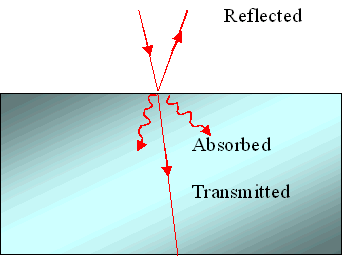absorption

Figure 1. Absorption as a result of the combined effect of Compton scattering and photoelectric absorption.

Figure 2. A ray of light striking a surface may be reflected, transmitted, or absorbed.
1. Absorption of light is the capture of photons by atoms, molecules, or ions, which results in a decrease in the intensity of light, or other electromagnetic radiation, as it passes through a substance. Absorption of electromagnetic radiation is the combined result of the Compton effect, σ, and photoelectric absorption, τ (Figure 1). If the intensity of the incident beam of radiation is I0, the intensity of the beam attenuated by absorption, If , may be written as:
If = I0 e-μρt
where t is the thickness of the absorbing medium and μ = σ + τ.
In astronomy, absorption occurs, for example, in the atmospheres of stars, planets, and moons, and in the interstellar medium. Absorption in Earth's atmosphere is one of the causes of atmospheric extinction; between the stars it occurs as interstellar extinction.
Absorption at a specific wavelength results in absorption lines or absorption bands; otherwise it is known as continuous absorption. Compare with emission.
2. More generally, absorption is any process by which a substance incorporates another substance into itself, or takes in radiant or sound energy. In chemistry it is distinguished from adsorption in which the adsorbed substance merely adheres to the surface of the absorbent. In absorption the absorbed matter permeates all of the absorber; this includes a gas taken in by a liquid, such as carbon dioxide by sodium hydroxide, and a liquid or gas absorbed by a solid, such as water by a gel. In air-pollution control and the chemical industries gas absorption is a key process, while the varying extent to which different surfaces absorb sound is an important factor in acoustic design.
3. In nuclear physics, neutrons produced by fission in a nuclear reactor are absorbed by materials such as boron in control rods or other materials making up the radiation shielding around the reactor.
4. In physiology, absorption refers to the uptake of fluids or other substances by the tissues of the body. Digested food is absorbed into the blood and lymph from the gastrointestinal tract. Most absorption of food occurs in the small intestine – in the jejunum and ileum – although alcohol is readily absorbed from the stomach. The small intestine is lined with minute finger-like processes (villi), which greatly increase its surface area and therefore the speed at which absorption can take place.


